Freewing T-45 Goshawk Super Scale 90mm EDF Jet
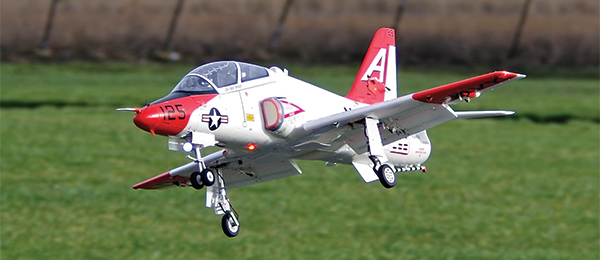
Written by Jon Barnes Take your foam jet experience to the next level Product review Photos by the author Read the full product review in the July 2016 issue of Model Aviation.
Specifications
• Model type: EDF jet • Skill level: Intermediate to advanced • Wingspan: 44.8 inches • Wing area: 512 square inches • Length: 56 inches • Weight: 129 ounces • Power system: 90mm electric ducted fan • Radio: Minimum seven-channel radio/receiver • Construction: EPO foam • Street price: $499Test-model details
• Motor used: Freewing 3748-1550 Kv brushless outrunner (installed) • Speed controller: Freewing 130-amp brushless with separate 8-amp BEC (installed) • Battery: Admiral 6S 22.2-volt 5,000 mAh 50C LiPo with EC5 connector • EDF: Freewing 90mm with 12-blade impeller (installed) • Radio system: Spektrum Black Edition DX9 DSMX 2.4 GHz transmitter; Spektrum AR8000 DSMX receiver • Ready-to-fly weight: 129 ounces • Flight duration: 3 to 4 minutesPluses
• Extremely high level of scale detail. • High blade count impeller produces excellent thrust, with accompanying realistic-sounding and ear-pleasing acoustics. • CNC aluminum suspension-equipped struts and sequenced, multipanel gear doors. • Operational speed brakes and LE slats. • Multipin wing connectors and wiring interface module help to tame the abundance of wiring.Minus
• Relatively short flight duration.Product review
Pilots who love flying foam-composition scale jets have, in the past, been forced to make a few obligatory concessions. Until recently, most mass-produced jet models typically featured a meager level of scale detail. Additionally, the electric ducted-fan (EDF) power systems included with many of the kits of yore were underpowered, out of balance, and obnoxiously noisy. Pilots who preferred any higher level of scale detail and/or a more powerful, better-sounding EDF power system were forced to spend countless hours engineering and improving their jet models. Although that process might be the best part of the hobby to a select few, most prospective EDF jet fliers probably prefer that a model come out of the box already equipped with an impressive level of scale detail and a smooth, appropriately powerful EDF power system preinstalled. Motion RC recently released a series of Freewing Super Scale 90mm EDF jets that are sure to please EDF-loving pilots interested in a scale jet model. The first kit to be released in the series was the popular T-45 Goshawk. The McDonnell Douglas T-45 Goshawk made its first flight in 1988. This carrier-capable aircraft has since been used extensively by the U.S. Navy and Marine Corps as a jet flight trainer. There have been more than a few T-45 kits available to modelers throughout the last few years, most of them done up in the trademark U.S. Navy International orange and white color scheme. Model pilots prone to protest the arrival of “yet another orange and white USN Goshawk” were stopped midsentence by the impressive list of features included with this 90mm EPO foam-composition EDF jet.
Freewing’s 90mm EDF-powered version of the U.S. Navy-themed T-45 Goshawk is stunningly detailed.
The T-45 is available in Plug and Play (PNP) and ARF Plus variants. The former includes all electronic components, while the latter omits the EDF unit and speed controller. The ARF Plus kit is perfect for pilots who prefer to source their own power system. The availability of this option does not infer that the 90mm EDF that Freewing installs in the PNP version is in any way a lackluster performer. To the contrary, this high-performance 90mm EDF uses a 12-blade impeller and endows the T-45 with plenty of thrust! The long list of scale-enhancing features included with this exquisitely detailed jet is guaranteed to fog the face masks of even the most jaded jet pilots. This model uses worm-gear-driven leading edge (LE) slats. To my knowledge, it is the first time that this unique and fully functional feature has ever been included on a mass-produced model! Sequenced, multipanel gear doors and trailing link suspension-equipped electric landing gear nicely replicate the geometry and functionality of the full-scale Goshawk’s tricycle landing gear. Rows of plastic vortex generators are positioned slightly aft of the wing’s LEs. Other cool plastic details include a tailhook, functional speed brakes, a pitot tube, and antennae. A removable cockpit and hatch includes a pair of pilot figures and a nicely detailed cockpit interior. The clear plastic canopy even mimics the explosive cord used to predetonate the full-scale T-45’s canopy milliseconds before the pilots’ ejection seats will fire. A full array of strobing and fixed navigation lights comes preinstalled, as does a small wiring interface module that helps to manage the abundance of wiring used on this full-featured model. Finally, Freewing did not simply add a few details to the wings and white stabilizers and call it a U.S. Navy scheme. The impressive number and variety of factory-applied maintenance graphics and U.S. Navy markings adorning every inch of this big Goshawk jet help it live up to its Super Scale moniker!
Assembly
The PNP version of the T-45 comes out of the box in such an advanced state of completion that there is no need to spend hours at one’s workbench assembling and prepping this detailed jet for its first flights. Pilots pulling the parts out of the box for the first time can instead use the time to savor the incredible variety of included scale details!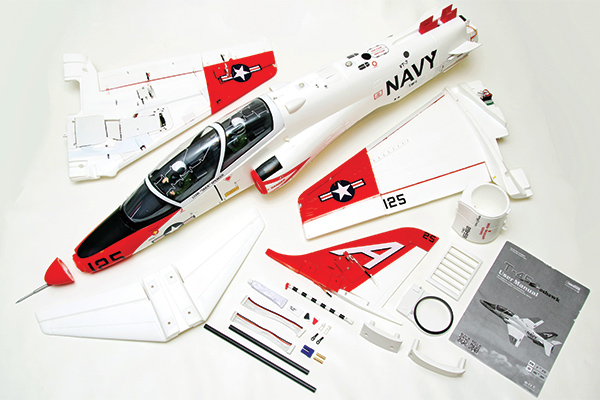
The only items that pilots will need to source to get this quick-assembling PNP kit in the air are a seven- to nine-channel receiver and a 6S 50C 5,000 mAh LiPo battery.
An abundance of plastic bits are used to enhance the scale outline of the Goshawk. Notable pieces include a striped tailhook and detailed cockpit with twin pilot figures. The cockpit instrumentation even includes a simulated lighted heads-up display! Freewing supplements the air supplied to the preinstalled 90mm EDF power system through the scale twin inlet ducts with a large auxiliary air inlet opening, located on the bottom of the fuselage just forward of the fan assembly. A large, rectangular, plastic, louvered inlet panel helps to prohibit the entry of potentially damaging foreign objects and debris. Best practices when assembling a PNP configuration kit include taking a little time to inspect the integrity of all of the control surface hinges and pushrod connections. Freewing’s use of ball-link-style connectors on the control surface side of the pushrods comes with the advantage of minimal backlash. This can help a model respond more crisply to control inputs and track more precisely in the air and on the ground. Actual assembly of the airframe involves mounting the horizontal and vertical stabilizer assemblies and two-piece wing. Removable fasteners allow pilots to easily break the model down for transport or replace damaged components when necessary. A little adhesive is required to mount the two different tail cone pieces and to attach the nose cone-mounted pitot tube. The entire nose cone assembly itself is conveniently engineered to be easily removable and is held in place using magnets. This helps prevent damage to the somewhat delicate component by popping it off for transport and storage. The two wing halves utilize multipin connectors. These conveniently aggregate all of the electronics used in each wing half onto one larger connector. This simplifies wing attachment and removal, and reduces the chances of making wrong connections when assembling the model at the field. Pilots who want to have independent control of all of the T-45’s features will need to source a minimum eight-channel receiver. A seven-channel receiver can alternately be pressed into service, although this option will require that the slats and flaps are connected to, and driven by, the same channel. As a longtime Spektrum radio system user, the form factor and number of channels offered by the Spektrum AR8000 DSMX eight-channel receiver made it the obvious choice for this high-performance jet. This full-range receiver’s use of a satellite receiver, which brings the added benefit of multipath redundancy, gives pilots an extra level of confidence. The length of the satellite receiver’s pigtail allowed it to be located forward of the main receiver, near the nose gear retract mechanism. The black and white assembly manual offers in-depth assembly and component replacement instructions. It includes a complete listing of the 14 servos preinstalled in the airframe, as well as their rotation and the lengths of their leads. A detailed printout and mapping of the included E04 wiring module assists pilots with the connection of all of the various lights and servo leads. The manual also recommends high- and low-rate throws, the proper center of gravity (CG) location, and that pilots configure the elevator’s neutral position to be slightly biased toward the down position.
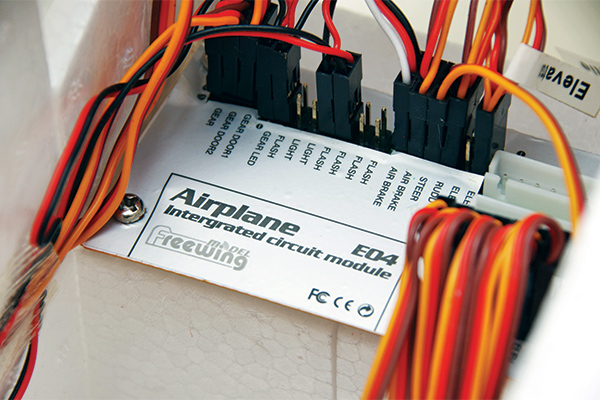
This full-featured T-45 includes an abundance of radio connections and wiring; Freewing’s use of the E04 Integrated Circuit Module helps keep it all as neat as possible.
Although the recommended six-cell 22.2-volt 5,000 mAh LiPo battery fits snugly into the battery bay, enough room exists to move it forward and aft for the optimum CG. Those who prefer to source their own high-performance 8S or even 10S EDF power system will want to opt for the ARF Plus version of this kit. The sole difference is that this kit omits the stock Freewing 90mm power system. All other electronics come included and preinstalled exactly as they do in the PNP version.
Flying
The importance of performing a thorough preflight routine is imperative. This helps to minimize any in-flight surprises—something most pilots prefer to avoid when flying a larger, high-performance EDF jet model such as the T-45. Positioning the big Admiral six-cell 5,000 mAh LiPo battery so that its forward edge is even with the Goshawk’s twin intakes balances the airframe within a few millimeters of the recommended CG. The assembly manual recommended a takeoff configuration of half flaps to allow the T-45 to rotate sooner than when takeoffs are performed without the flaps deployed. Whatever takeoff flap configuration a pilot elects to use, the airframe needs time to accelerate to a proper rotation speed. Although the thrust produced by the Freewing 90mm EDF motivates this 8-pound jet hastily forward, the sound produced by the 12-blade impeller at full throttle is a guaranteed grin generator! The aluminum trailing link tricycle landing gear nicely absorbs aberrations in the runway surface and helps to keep this jet tracking nicely in the takeoff roll. Only minimal rudder corrections are typically required. Scale EDF jets fly best when operated in a scalelike manner. The higher wing loading of this airframe precludes pilots yanking and banking it around in the same manner that they would a lightly loaded sport jet. The throttle should generally be kept above 50% at all times and turns should be kept on the gradual side; however, these statements are not intended to infer that this model is difficult to fly. Keep the speed up and the transmitter inputs controlled and deliberate and the Freewing T-45 will happily cruise around the sky without any bad behavior. High-rate control authority gives a pilot the ability to loop and roll this T-45 with only modest amounts of stick movement required. The extreme level of out-of-the-box scale detailing, combined with the incredibly smooth, turbine-like sound of the Freewing 90mm EDF power system, give this jet an in-flight appearance and presence that surpasses any EDF model I have experienced!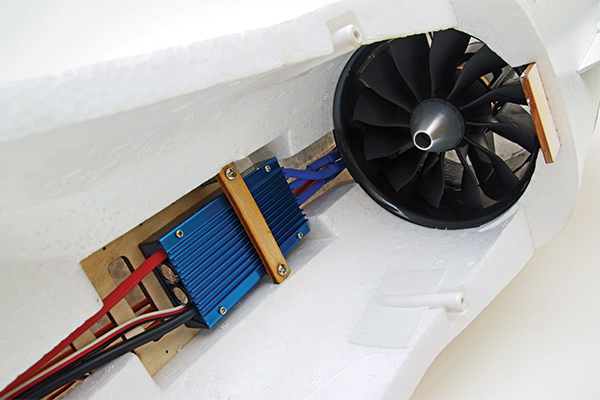
Freewing’s 12-blade 90mm EDF power system make this jet sound as good as it looks.
The impressive performance offered by this 90mm EDF jet comes with one caveat: typical flight durations using the stock Freewing six-cell 90mm EDF power system will be in the range of three to four minutes. Although many pilots use a countdown timer to alert them to the need to land, this model is the perfect candidate for the use of a radio telemetry system. Receiving real-time feedback about the voltage of the flight battery enables a pilot to maximize the flight durations of this high-performance model and minimize any chance of accidentally flying this jet into a low-voltage cutoff condition. Most pilots will agree that the landing is what separates the men from the boys. Freewing’s use of LE and speed brakes on the Goshawk give pilots additional resources that can help bring this big jet safely home every time. The best landing approaches will occur if pilots give this model a little time to adjust to each applied change in configuration. Quickly and simultaneously dumping flaps, gear, slats and speed brakes can potentially upset the airframe and get a pilot into trouble. Performing a controlled and traditional rectangular landing approach, with nice extended legs and gradual, arcing transitions through the corners, is a recipe for the perfect, scalelike landing. Well-planned deployment of each individual piece of the airframe should be a pilot’s goal when shooting an approach. An upwind pass directly over the runway centerline is a great way to visually verify that a pilot has all three landing gear down. The first notch of flaps can be deployed with the jet turning crosswind to downwind. Using a transmitter’s flap speed setting to substantially slow the movement of the flaps allows the jet to settle into the new configuration with minimal pitch changes. Full flaps and slats can be deployed on either the crosswind leg or the base leg. As the airframe gets “dirty,” pilots will need to actively modulate the throttle to maintain airspeed. Fly the T-45 all the way into the numbers and it can execute the prettiest, nose-high landing approach imaginable!
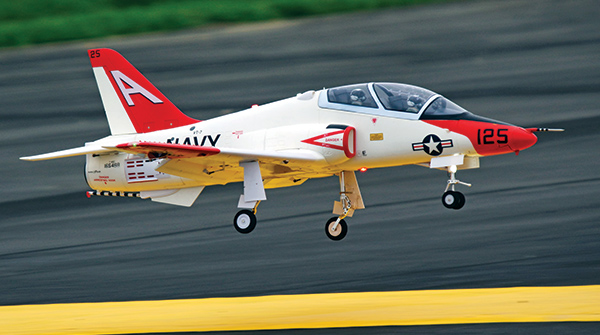
The suspension-equipped aluminum trailing link landing gear helps the Goshawk “stick” to the runway when landing.
Pilot preference will dictate whether the speed brakes are deployed on final approach or during the landing rollout. The sight of this superbly scalelike model on final, with its nose gear mounted and super bright landing light ablaze, will send a shiver of excitement down the spine of pilots and onlookers alike.










1 comments
goshawk
Add new comment